Courcelette Memorial

The Courcelette Memorial is a Canadian war memorial that commemorates the actions of the Canadian Corps in the final two and a half months of the infamous four-and-a-half-month-long Somme Offensive of the First World War. The Canadians participated at the Somme from early September to the British offensives end in mid-November 1916, engaging in several of the battles-within-the-battle of the Somme, including actions at: Flers-Courcelette, Thiepval Ridge, the Ancre Heights, the Ancre as well as a small role in providing relief to the First Australian Imperial Force in the final days of the Battle of Pozières. The battles on the Somme were the first in which all four Canadian divisions participated in the same battle, although not together in a cohesive formation. The Canadian divisions suffered over 24,000 casualties.
Excerpt from the Wikipedia article Courcelette Memorial (License: CC BY-SA 3.0, Authors, Images).Courcelette Memorial
D 929, Péronne
Geographical coordinates (GPS) Address Website External links Nearby Places Show on map
Geographical coordinates (GPS)
| Latitude | Longitude |
|---|---|
| N 50.054166666667 ° | E 2.7513888888889 ° |
Address
D 929
80300 Péronne
Hauts-de-France, France
Open on Google Maps









